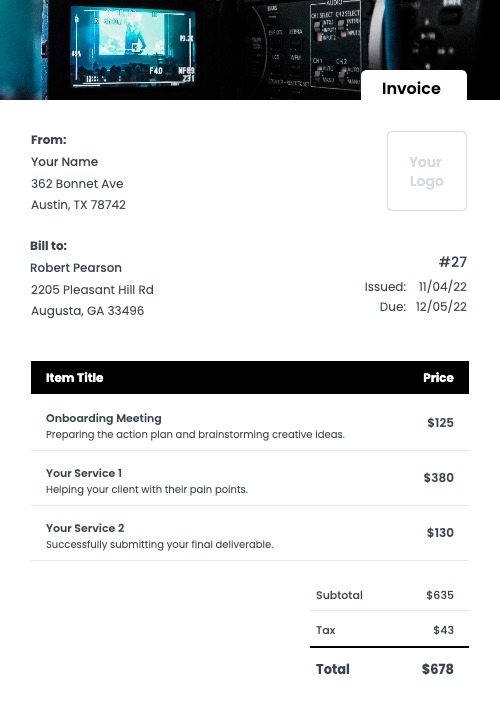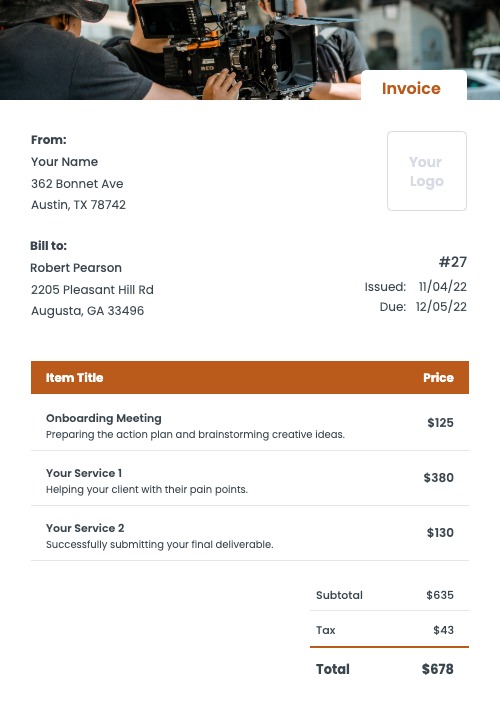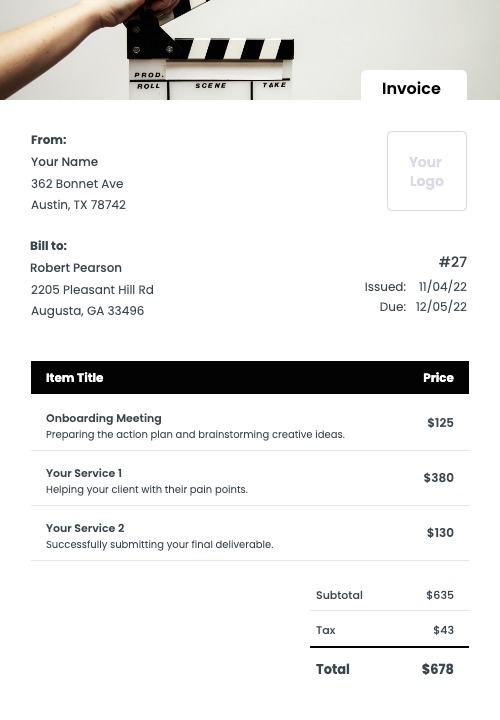Filmmaking Invoice Templates
Cinematography is an art form, and you should be paid like the artist you are. With Kosmo’s filmmaking invoice template, creating invoices for your work is a breeze.
Get paid faster with online payments, automatic late payment reminders and more. With Kosmo, you can focus on your passion and leave the billing to us.
Create Your Own Invoices For Free



How To Create A Filmmaking Invoice That Gets Paid
As a filmmaker, you are responsible for capturing the best moments of a film or video production. Your work might include setting up cameras and other equipment, shooting footage, and editing the final product.
To make sure that you are fairly compensated for your work, it is important to itemize your services in your invoices. For example, if you are working on a feature film, your invoice might include items such as “location scouting”, “camera setup”, “lighting”, “sound”, “gripping”, “editing”, and “color correction”.
If you are working on a corporate video, your invoice might include items such as “consultation”, “scriptwriting”, “storyboarding”, “filming”, “editing”, and “delivery”.
By itemizing your services, you can make sure that your clients understand exactly what they are paying for, and you can ensure that you are fairly compensated for your work.

Creating an invoice step by step
- Download a template
- Change the colors of the invoice
- Add your own company information
- Add your client’s details
- Add the line items
- Calculate applicable taxes and discounts
- Check the final amount
- Add your payment terms, notes and a due date
- Send the invoice to your client
- Keep track of paid and unpaid invoices
Or use Kosmo to make the process simple and fast.
Creating A Filmmaking Invoice With Kosmo

1. Style and customize
Choose an invoice template that suits your industry and style. Next, adjust the invoice by changing the colors and by uploading your logo to match your brand.

2. Enter line items
Enter all items you’d like to bill to the client. Add a title and an optional description to provide more details regarding the work completed. Lastly, add the cost for each item.

3. Send the invoice
Choose your preferred payment method and add any terms & conditions. Hit “send” to email the invoice and receive a notification once your client has paid the invoice.
Get paid on time, every time.
Create professional invoices with Kosmo and level up your business today.
Why Should You Use A Filmmaking Invoice Template?
A filmmaking invoice template is a great way to keep track of your expenses and income while working on a film project. It can help you stay organized and on budget, and save time by having all of your information in one place.
A filmmaking invoice template can help you keep track of your film project’s budget by itemizing your expenses and income. This can help you stay on track and avoid overspending. Having all of your information in one place can also save you time, as you won’t need to search for receipts or invoices.
A filmmaking invoice template can be customized to fit your specific needs. You can add your own logo, company name, and contact information. You can also add notes or special instructions for your clients. This can help you stay organized and ensure that your clients receive the correct information.

Filmmaking Invoice Requirements Checklist
- A unique invoice number.
- The payment due date.
- The date when the invoice was issued.
- Your name and/or company name and your contact information.
- Your client’s name and/or company name and contact information.
- A detailed line-by-line break down of your services and products.
- Any applicable taxes and discounts.
- The calculated total price of the invoice.
- Accepted payment methods, for example credit card, check, PayPal and others.
- Additional notes about payment terms, late fees and more.
When Is The Right Time To Send My Filmmaking Invoice?
The right time to send your filmmaking invoice is when the project is completed and you have delivered the final product to the client. This gives them time to review the project and make sure that everything is to their satisfaction. If there are any changes that need to be made, you can make those before sending the invoice. Once the client is happy with the final product, you can send them an invoice for payment.
Kosmo vs Manual Invoices
| Feature | Kosmo | Template |
|---|---|---|
| Create professionally designed invoices. | ||
| Securely send invoices to clients via email. | ||
| Get paid faster with online payments. | ||
| Automatically calculate invoice totals. | ||
| Track payments and invoices in real-time. | ||
| Receive automatic reminders for overdue invoices. | ||
| Access your invoices from anywhere in the world. | ||
| Get Started For Free |
How Invoicing Software Can Help You
Save Time
Invoicing software can help you save a lot of time. It allows you to create and send beautiful invoices quickly and easily. This means that you can spend less time on administrative tasks, and more time on your work.
Get Paid Faster
An invoicing software like Kosmo can help you get paid faster. When you send invoices electronically, you can often get paid quicker than if you had to wait for a check to arrive in the mail.
Organize Your Business
When all of your invoices are stored in one place, it is easier to keep track of what is owed and when payments are due. This can help you avoid getting paid late.
Professional Design
With invoicing software, you can often choose from a variety of templates and designs. This means that your invoices will look professional and polished. So take your pick and make your business look great.
Get paid on time, every time.
Create professional invoices with Kosmo and level up your business today.
FAQs (Frequently Asked Questions)
Who needs to use a filmmaking invoice?
A filmmaking invoice is a document that is used by filmmakers to request payment for their services. This type of invoice is typically used by freelance filmmakers, or those who are self-employed. The filmmaking invoice should include all of the pertinent information regarding the services rendered, as well as the terms of payment.
How do you bill for filmmaking work?
There are a few ways to bill for filmmaking work, but the most common method is to charge by the day. This means that you will charge a certain amount for each day that you work on a project. This amount can vary depending on your experience and the scope of the project. For example, a feature film will typically cost more than a corporate video.
Another way to bill for filmmaking work is to charge by the hour. This is less common, but can be more appropriate for smaller projects. For example, if you are hired to shoot a music video, you may charge an hourly rate. This way, the client only pays for the time you actually spend working on the project.
The final way to bill for filmmaking work is to charge a flat fee. This means that you will charge one price for the entire project, no matter how long it takes you to complete it. This is often used for very large projects, such as feature films. It can also be used for smaller projects, if the client is willing to pay a bit more upfront.
How to create a filmmaking invoice?
he first step is to list out all of the services that you provided as part of your filmmaking services. This might include things like writing, directing, shooting, editing, and so on. Next to each service, list out the corresponding rate that you charge for that service. For example, if you charge $100 for writing, then you would list “Writing” next to $100 on your invoice. Once you have all of the services and rates listed out, add up the total to get the grand total for the invoice. Finally, be sure to include your contact information on the invoice so that the client knows who to contact with any questions.
How can I make my filmmaking invoice stand out?
When it comes to making your filmmaking invoice stand out, there are a few key things you can do to really make it pop. First, consider using a unique and eye-catching design. This could be anything from a custom logo to an interesting color scheme. Secondly, make sure your invoice is clear and concise. Include all of the relevant information in a easy-to-read format. Finally, don’t forget to add a personal touch! A handwritten note or even a small gift can go a long way in making your invoice stand out from the rest.
What are some tips for creating a filmmaking invoice?
When creating a filmmaking invoice, it is important to include all relevant information regarding the project. This includes the name and contact information of the client, the name of the project, the dates of the project, the services rendered, the total cost of the project, and any other relevant details.
It is also important to format the invoice in a professional and easy-to-read manner. This means including a header with the name and contact information of the business, as well as a footer with invoicing and payment terms. The body of the invoice should be clear and concise, listing all services rendered and their associated costs.
Finally, it is important to send the invoice in a timely manner. This means sending it as soon as the project is completed, or within a few days if possible. If the invoice is not received in a timely manner, the client may become impatient and look elsewhere for their filmmaking needs.
What are some common mistakes to avoid when creating a filmmaking invoice?
When creating a filmmaking invoice, some common mistakes to avoid include:
1. Not being clear and concise about what services were rendered. Be sure to include a detailed description of the work that was performed, as well as the dates on which the work was completed.
2. Not itemizing each individual service and its corresponding fee. This will make it difficult for the client to understand exactly what they are being charged for, and may lead to them disputing the charges.
3. Not including your contact information. Be sure to include your name, address, phone number, and email address so that the client can easily get in touch with you if they have any questions about the invoice.
4. Not specifying the payment terms. Be sure to include the date by which the invoice is due, as well as the methods of payment that you accept.
5. Not providing a breakdown of expenses. If the invoice includes charges for expenses such as travel or materials, be sure to itemize these charges so that the client can see exactly what they are being charged for.
6. Not indicating whether or not taxes are included in the total. Be sure to include this information so that the client knows whether or not they need to budget for additional taxes.
7. Not including a late payment fee. If you plan to charge a late fee for payments received after the due date, be sure to include this information on the invoice.